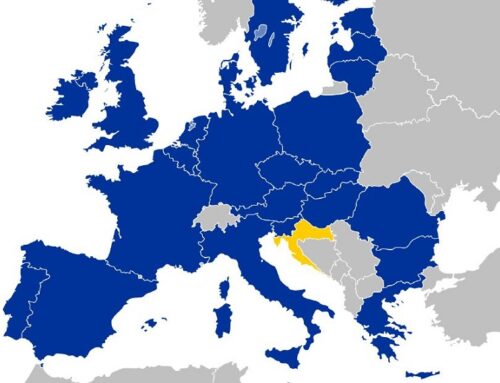As I meet tourists, I keep hearing – “I did not expect Prague to be so beautiful”. Western European tourists come to Prague and much to their surprise love it. The reputation of the developing Central and Eastern Europe (CEE)[1] combined with its communist past for years has not been that of a tourist destination. However, recent years have seen the rise in the number of Western tourists in Poland, Czech Republic and Hungary, to name a few. Not only are the architectural marvels but also the recent economic success of Central and Eastern Europe that catches the watchful eye of the tourists. In the past 30 years, the GDP growth rate of Eastern Bloc (3,6 %) has exceeded that of Western Europe (2,1%), despite the historical hurdles of the former. [2]
Undoubtedly, transformation from communism to capitalism caused economic success, so did entrance into the European Union. Even though, shock therapies are usually a subject of scrutiny, it seems they bore their fruits. The Polish and Slovak economies have grown sevenfold, accordingly the Baltic states, Romania and Czech Republic saw a fivefold growth.[3] What differentiates former Eastern Bloc EU members from their counterparts in the USSR is a lack of a situation where a minority seized the majority of the state enterprise.[4] Former Eastern Bloc European countries remained some of the most equal in the world.[5] Poland and Hungary have reached equality levels observed in France and Spain. The Czech Republic ranks third lowest among OECD countries in income inequality.[6] However, former Soviet Union members, the Baltic states demonstrate quite a high wealth inequality level, seemingly following a path that is more comparable to Russia and Ukraine, where a minority of people came to possess a majority of the state enterprise. The former USSR member’s inequality was originally driven by the wild West-like privatisation, liberalisation and deregulations reforms as they tried to cope with transition to the free market. Later, the inequality was exacerbated by globalisation and technological changes as citizens faced relatively low income and no coherent wealth redistribution policies from their government at the peril of these challenges.[7] The Baltic states level is similar to that of Germany, one of Europe’s most wealth-unequal nations.[8] Despite communism leaving all of these countries with basket-case economies, it also left a well-educated society and a young ambitious generation driven by the desired change. Poland especially benefited from this combination as the country enjoys a class of entrepreneurs and small businesses instead of lawless oligarchs. Eastern Bloc countries, unlike the former USSR, also inherited low levels of inequality. The contrast is especially striking in the Baltic states, which followed a path similar to its Eastern Bloc counterparts as it joined the EU and enjoyed foreign investment incentives. Scholars conclude that the Baltic states wealth-inequality is understood through the opening market opportunities, which in the Baltic states allowed the engagement of human resources as the market economy was being built. As a result of this policy, citizens who demonstrate high market activity and education are rewarded by higher incomes and upward mobility, whereas little activity in labour relations came to be associated with downward mobility and low income.[9] I would also suggest that the dissimilar process of the elite-change in Eastern Bloc and USSR after the fall of communism could have influenced the difference between the wealth-inequality. Being under more direct Kremlin’s control the Baltic states had drastically more communist members as it was a means of survival or social mobility for a lot of them, making it more problematic to assess, who was a true party supporter and collaborator, leaving a higher number of former officials in power, which could have led to the above-mentioned wild-West privatisation with these officials managing to get a bigger piece of the pie. In the Eastern Bloc, however, the former party officials were titled as collaborators and deprived of such luxury as they were deprived of their power. Additionally, Eastern bloc countries formed organised movements during Gorbachev’s time, most notably, Solidarność, a Polish organisation, which would be the watchful eye during privatisation, reducing the chances of shock therapy’s abuse.[10] Former USSR countries due to harsher crackdown from Moscow had no chance of forming these mass movements – another potential factor. Additionally, in Lithuania, having rebranded as the Lithuanian Democratic Labour Party, the communist came back to power in 1993.
Despite the Baltic states experiencing issues with wealth distribution, life expectancy increased as much as 10% in some regions and overall quality of life has increased as well as countries’ international prestige.[11] CEE make up for 20% of the EU’s population and its GDP per capita is almost double of the EU average.[12] The region also boasts high tourism growth potential as it has become drastically less dependent on Russian tourists in recent years and has become more reliant on inter-regional tourists. Additionally, Eastern Europe is becoming a more popular destination among global tourists, diversifying an image of a regular visitor to the country. Foreign investment incentives and IT development are two other important factors that contribute to growth in the region. These developments have been beneficial for the immediate labour market stabilisation and for laying an important fundament for future economic growth.[13] Six Central and Eastern European countries feature in the list of the top 20 developers in the global index.[14] This is a result of elaborative policies and incentives that are being implemented to this day. As the global trend in demographic decline can be seen, the importance of state technological adaptability proves to be more crucial than ever. Central and Eastern European governments are among the most business-friendly in the EU, undoubtedly, more economic growth will be seen in the upcoming years. The migration trends in CEE since the fall of communists made an impression of the likelihood of an ageing population as CEE went to the West. However, many scholars expect an increased migration and return of former migrants to Central and Eastern Europe as the economies continue to develop. CEE states are well aware of the upcoming trend and facilitate it through benefits and incentives for highly skilled foreigners and returnees.
Vaclav Havel stressed in his Power of the Powerless that the Central and Eastern European experience of communism in the 1970s was instrumental for the Western European future. CEE experience highlights the importance of a democratic legal order and it goes without saying that citizens of Central and Eastern Europe do not take for granted their independence and freedom. Ukraine’s military successes highlight this time and again. So does the support of CEE allies, who have provided more than 80% of the promised supplies compared to 50% of the Western allies.[15] Mark Twain said that there are three types of lies: lies, damn lies and statistics. Central and Eastern Europe has gone through remarkable success and it is highly likely that more economic and social development is on the cards. However, the CEE is somewhat a battlefield between modernity and traditionalism. A tremendous support has been shown to Ukraine, however, in former industrial areas and rural regions highly conservative anti-Western, anti-EU and sometimes even pro-Russian narrative can be seen. LGBTQ+ question remains to be a problematic one as populists exploit it for their benefit (Only Estonia successfully passed same-sex marriage bill from the analysed countries so far, however, Slovenia was the first from former communist block to introduce same-sex marriage). However, Viktor Orban and vandal repainting of the rainbow crossroad during Vilnius pride are not Central and Eastern European phenomena. They are part of a way bigger picture – a global fight between traditionalists and modernists.
Traditionalism is a response to the new age emerging before our eyes. It is a result of industrialism and a drastic demographic shift. In fact, I would venture to suggest that there is a link between Bin Laden’s letter to America, Putin’s denunciation of the ‘collective’ West, a guy at the Trump rally talking about Biden’s double and Kotleba’s LSNS[16]
A demographic shift is upon us and it comes bearing extraordinary implications. Contrary to popular belief, it is not just Europe experiencing the low birth rates, they happen to dwindle globally.
In 1760, the world population was about 610.000.000, in 1960, 3 billion and in 2020 it is 7.7 billion.[17] The population growth is accentuating and remarkable. The continuation of this growth is rightfully depicted as a catastrophe, becoming a cash-cow plot for Marvel blockbusters.
According to the UN, the world’s population is expected to increase to an overwhelming 9.8 billion by 2050.[18] Surfacely, it comes across, as if we are doomed. But remember Mark Twain’s three types of lies: lies, damn lies and statistics. Indeed, 2 billion is a growth but growth only by 50% of the birth rate from previous years. The population may be growing but the birth rate is declining and it is a global phenomenon. The birthrates are plunging all over the world.
There is a magical number – 2.1, a number, which should it be followed, is capable of maintaining a perfect demographic balance, all things being equal. The population is power. Governments are desperate to keep their population in a Goldilocks zone of 2.1. Population dictates the majority of the governmental policies: tax income, army size, green-house reduction, retirement age, and parental leave. Europe’s rate is 1.4 but it is not an exception, it is just an ahead-of-the-curve example of the global trend.
In 2100, the UN world population estimate is mapped to be 10.4 billion, which indicates population growth only by 10%.[19] Some forecasting agencies predict a decrease in the second half of the century with the population reaching 9.7 billion by 2070, followed by a decline.[20]
The population explosion is coming to an end. In 1960, the birth rate was 4.5, in 2001, it plunged to 2.7, predicted estimate for 2050 is 2,05, just below the ideal replacement fertility rate. According to the Lancet, the predicted global fertility rate will be 1.6. By the end of this century.[21]
In 1800, it wasn’t unheard of to have eight children. But only some of them would make it to adulthood and have children of their own. With the advent of more accessible and advanced medicine, hygiene and food production, the birth rates remained the same. Why? Well, humans like to have sex, contraception didn’t exist and most importantly children were the basis of wealth and retirement. Every pair of hands added to the household income when agriculture was at its base. Children brought about prosperity and retirement income – the more children, the better. This societal structure limited women’s role to childbearing.
Old habits die hard and early urbanisation did little to change this family behaviour pattern. As families moved to cities, early industrial society did not require skilled workers, maintaining children’s profitable economic status; parents could send the children to a primitive factory from the age of six, collecting their pay. However, as industries became more complex, the need for skilled workers increased, changing the role of the child in the household economy. Slowly but surely, instead of providing, children began consuming, being no longer economically viable. I am 19 years old and I am yet to generate any profit for my parents, if anything I have some debt to pay.
In the early 1900, it was still possible for children to be providers, finding employment during their puberty, that is why some of our grandparents may come from families of nine or eight. As the industry continued to advance, the reality of children being a burden sunk in, giving rise to a new type of family. Birth control was an important factor in the plunging number of kids per household but nothing is as important as the rising costs of raising a child.
Medical successes influenced both birth rate and life expectancy, which nearly doubled in the past two centuries. Not only did child-bearing shift from being a woman’s main responsibility in the existing economic reality, but it also started to constitute a far lesser part of their life now. As education becomes the primary source of income with a bachelor’s degree becoming a minimum requirement for participation in the labour force, people become financially stable later in life, shifting marriage patterns. The less time women spend nurturing children, the less dependent they are on men. Single motherhood was suicidal in the 19th century, it is nothing short of normal nowadays. Marriage is no longer economic. It has become a result of love and emotions instead of profit. Love is great but it comes and goes. Marriage for emotional reasons eventually will lead to more divorces. Serial polygamy is remerging. It used to be a means of economic necessity upon one’s partner’s death, they would remarry. Nowadays, one remarries because they found a new love. In between the two periods of two different serial polygamy episodes, marriage was a matter of habit, having its roots in financial codependency, social dictation and timely attachment. That is a traditional view of marriage, we will come back to it.
The timeline of marriage in one’s life changed, too. Instead of marrying during puberty, people are now typically marrying during their late twenties or early thirties. Longer education and later marriage lead to the inevitability of premarital sex, emerging new patterns: 1) when people are sexually active and financially unstable; 2) when people are financially stable and sexually active and chose to not reproduce. None of these patterns mentions marriage, which has become decoupled from reproduction. Having a kid outside of wedlock is not extraordinary, nor is the choice of not having a child during marriage.
Traditional life is coming to an end. Previous social patterns have been forced to change thanks to lower fertility, longer lives and the need for higher education. It can be argued that this is a Euro- or Americocentric view. In a way. All of this is true for the more advanced countries but the fertility rate is decreasing everywhere, so the rest of the world will experience the same crisis, not at the same rate but the same trends are prevailing. A family may have eight children in Bangladesh now but soon it will be an economic suicide. Women having fewer children is not a reversible process. Ten children in 19th century Germany might have been heaven-sent but ten children in 21st century Germany is an economic catastrophe. Industrialised urban world is inept for a large family as an average household unit.
The change won’t stop and the inability to accept that is what unites the traditionalists all over the world, be they vehement Trump supporters, Russian/ Slovak nationalists or fundamentalists in the Middle East. Every religion has a radical fundamentalist branch, it is not about Islam, it is about the connection between any religion and reproduction. In pro-life arguments, supporters quote Leviticus. A bad workman always blames his tools. A person in disagreement with change will always allude to his source of stability (e.g., religious writing) and find a preconceived message no matter what.
The demographic shift has drastically affected the more educated and the most economically disadvantaged. Social divergence for the poor in the form of a dysfunctional family has been a norm since the industrial revolution. However, between the educated, the rich and the poor, there is another plaster of the population. For blue and pink-collar workers, education is drastically shorter, resulting in a briefer period between puberty and childbirth. Thus, this segment of the population marries and reproduces earlier. Financial implications of divorce for them are drastically higher, creating non-emotional glue that holds their marriages together. In their worldview, divorce and premarital sex involve consequentialism; it is simply costlier. This tends to be the cohort that constitutes social conservatism. It is a relatively small but powerful part of the population. Their power comes from their adamant support for tradition, stability and values. Values. The more educated class has values but it will be years before they will become the values – a merging of their lifestyles into a coherent transnational moral system. This advantage enables the social conservatives to speak with the authority of tradition and system. But regardless of this advantage, the traditional distinction between men and women is crumbling. Fewer and fewer women are bound to their traditional roles and that is going to be the trend as there are fewer children, longer life expectancy and uneconomic marriages. Divorce, premarital sex and abortions are inevitable in the urbanised and industrialised world. Civil unions, marriage without children, and queerness are becoming more and more unextraordinary. If feelings are the foundation of marriage and reproduction no longer is, what makes a queer marriage different?
Everything that traditionalists oppose all over the world is a result of the demographic shift. If anything, the distance between reality and the shift is getting closer and closer by the day. All of the traditionalist opposition is tied to the number of children, in other words, the birth rate, which is going to decrease – they argue for large families. Large families require an inevitable traditional role for a woman, early marriage, and a ban on premarital sex, abortion and homosexuality. At its core, the traditional principle is about having more children. Even the American war on drag can be traced to the demographic shift and industrialisation. Tradition is associated with morals, if we are shifting away from traditions we are becoming immoral. Traditionalists may have the advantage of this thinking but there is no stopping the demographic shift, there is no stopping change, there is no stopping formation of the new system with new traditions.
So, we should not be too overwhelmed by the traditionalist thinking and their manifestation in the emergence of the far-right parties. Nor should we disregard it, after all that was what Steinhardt, American diplomat to Czechoslovakia did in mid-February of 1948. He said that the communists would never take power in Czechoslovakia because the democratic roots were too deep in the country. Sadly, we came to realise how incorrect he was in his assessment. However, if one were to directly trace the direction and policies of the Central and Eastern European governments, the situation is drastically different from 1948 Czechoslovakia but we must keep our eyes open.
References:
[1] Referred in the sense of the former Eastern Bloc and the Baltic states – former communist countries in the European Union
[2] https://ec.europa.eu/eurostat/databrowser/view/tec00115/default/table?lang=en; https://ec.europa.eu/eurostat/databrowser/view/sdg_08_10/default/table; https://ec.europa.eu/eurostat/databrowser/view/NAMA_10_GDP/default/table?lang=en&category=na1
0.nama10.nama_10_ma
[3]https://www.theguardian.com/world/2019/oct/26/this-is-the-golden-age-eastern-europes-extraordinary-30-year-revival
[4] Ibid
[5] Ibid
[6] https://www.socialwatch.org/node/18320
[7] Ibid
[8] https://onlinelibrary.wiley.com/doi/abs/10.1111/ecot.12257
[9] Titma, Mikk, and Rein Murakas. “Income Inequalities in the Baltic States.” International Journal of Sociology 34, no. 2 (2004): 39–71. http://www.jstor.org/stable/20628711.
[10] https://www.theguardian.com/world/2019/oct/26/this-is-the-golden-age-eastern-europes-extraordinary-30-year-revival
[11] ibid
[12] https://www.phocuswire.com/growth-potential-central-and-eastern-europe-domestic-tourism
[13] https://www.globsec.org/sites/default/files/2020-10/The-Future-of-Tech-Startups-in-Central-Eastern-Europe.pdfhttps://wiiw.ac.at/foreign-direct-investment-strengthens-central-and-eastern-europe-s-economies-n-578.html
[15]https://meduza.io/news/2023/07/07/kilskiy-institut-ukraina-poluchila-tolko-polovinu-obeschannogo-zapadom-tyazhelogo-vooruzheniya; https://www.ifw-kiel.de/publications/media-information/2023/ukraine-support-tracker-despite-military-offensive-new-pledges-of-support-remain-low/
[16] Slovak far-right neo-Nazi party advocating for closer ties with Russia and breakaway from the EU. Some members of the party have been charged with Holocaust denying, one of the main ideologies of the party is being highly anti-Romani and anti-immigrant. The party was present in the national parliament in 2016 and 2020. In 2019, they won two seats in the European Party
[17] https://www.worldometers.info/world-population/world-population-by-year/
[18] https://www.un.org/en/global-issues/population#:~:text=The%20world’s%20population%20is%20expected,billion%20in%20the%20mid%2D2080s.
[19] https://www.un.org/en/global-issues/population#:~:text=The%20world’s%20population%20is%20expected,billion%20in%20the%20mid%2D2080s.
[20] https://www.nature.com/articles/d41586-021-02522-6
[21] https://www.thelancet.com/article/S0140-6736(20)30677-2/fulltext





